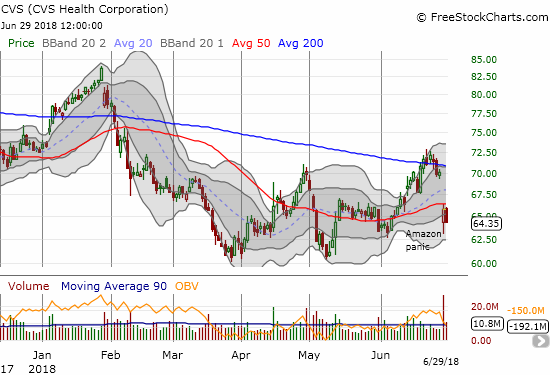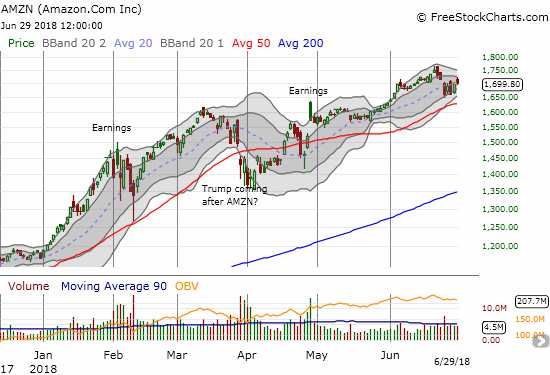Another Amazon Panic broke out last week. Amazon.com (AMZN) announced its purchase of PillPack as part of its entry into the lucrative business of selling drugs. The news immediately took down pill pushers like Walgreens Boot Alliance (WBA) and CVS Health Corporation (CVS). While WBA looks like it is already bottoming, sellers followed through with fresh pressure on CVS.


For WBA, buyers took the stock well off intraday lows. This pattern looks like a bottom awaiting confirmation which means a new closing low would be particularly bearish. For CVS, The stock is in no-man’s land with ominous looking resistance from 50 and 200DMAs. Over the longer-term, both stocks are technically damaged as implied by the downtrending 200DMAs and recent multi-year lows. Thus, even a bounce from current levels will likely present new opportunities to go short.
There is a huge irony in AMZN taking down WBA just days after the Dow Jones Industrial Average (DOW) decided to include WBA in its archaic index to replace General Electric (GE). Now that AMZN will be selling just about everything WBA does, AMZN’s deal delivers the double whammy of pressuring WBA’s valuation and worsening the Dow’s decision to skip over AMZN because of the stock’s price level.
Typically, I eagerly buy into these Amazon-inspired rush for the exits in anticipation of a relief bounce as panic subsides and calmer hands prevail. The trade has worked with remarkable consistency. THIS time around, I am not interested in buying. I think THIS time is different even if the obligatory bounce happens.
Through its acquisition, AMZN will succeed in driving drug prices downward because pharmacy prices are often inflated and highly variable. These high prices allow a true competitor like AMZN to flatten out the playing field. Just a week ago I discovered pharmacy price inflation after my wife decided to shop around for some very expensive drugs. She used a site called Good RX that she recently discovered. The site directed her to Walmart (WMT) and, lo and behold, what would have been a $1000+ bill at Walgreens turned into a bill under $200.
Astonished and baffled by the price differential, I checked on Good RX to try to get an understanding. After all, I always thought one pharmacy is just as good as the next one. Turns out I have been dead wrong. In a post titled “Shop Around to Save More on Your Prescriptions“, Good RX provided information from a recent study in the Journal of the American Medical Association (JAMA) about the wide price differential in pricing for heart medications in zip codes with more than 4 pharmacies. The article on the study, titled “Variability in Retail Pricing of Generic Drugs for Heart Failure,” reveals the following startling findings:
“…The price range was wide…for example, the cost of a 30-day supply of digoxin (0.25 mg) plus higher-dose lisinopril and carvedilol varied from $12.00 to $397.58 (median price, $70.68). Small percentages of pharmacies charged less than $25 for 30-day supplies and less than $100 for 90-day supplies for all 3 drugs (1.7% [n = 3] and 5.3% [n = 9], respectively). Digoxin was consistently the most expensive drug. Only 1 chain had consistent pricing across its stores.”
While the study is limited to three drugs, my personal experience added more power to these results. To the extent these kinds of discrepancies and variations are endemic to the industry, AMZN has found a great opportunity to grow market share and trim the profit margins of big pharmacies. Perhaps profits pressures will also cascade backward into the supply chain for drugs.
I am sure it will take time for investors to fully absorb this reality, especially since AMZN will not be able to establish a mass presence overnight. I will use that time to identify ideal opportunities for establishing shorts. New lows in WBA and/or CVS might be just the start to a fresh downdraft for these shares.

Source for charts: FreeStockCharts.com
